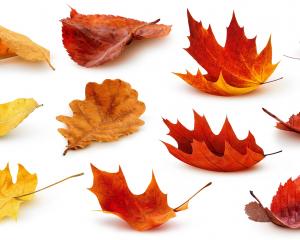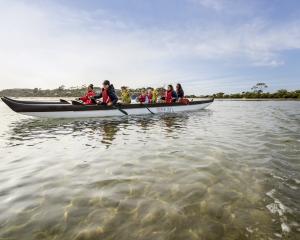
Dr Robert Smith kept his eyes on the horizon, waiting for the shimmering water to break and reveal a sign of life below. Aside from the occasional seabird plunging beneath the surface, or single dolphin breaching for a breath of air, it had so far been a relatively uneventful trip for the University of Otago research boat, RV Polaris II.
The seas were calm — until, suddenly, they weren’t. Once the boat reached the boundary of the Southland Current, the waters came to life.
"We knew when we reached it," Dr Smith, a physical oceanographer at the University of Otago, says with a grin.
"The marine life was really just kicking off; whales, dolphins, fur seals at the surface, big boils of fish deep below. Life is really abundant in that area," he explains, "and it’s all because of the Southland Current".
The Southland Current is an oceanic current that moves water up the eastern coast of Aotearoa’s South Island. The water feeding into the Southland Current comes from two places: about 20% is warm water from the Tasman Sea, while the remaining 80% is cold water coming up from the Southern Ocean.
The "Southland Front" is the point where they converge. Because these bodies of water come from different places, they carry different nutrients; when they combine, they create a "magic" nutrient potion, creating the perfect conditions for abundant and diverse sea life.
Ask any marine scientist who has made the boat trip out to the centre of the Southland Current, and they will light up with tales of incredible wildlife encounters.
However, the ocean is changing. Warming events, such as heat waves, have become more common in our oceans in recent years.
There is concern about the changing temperatures of currents all around the world, including the surface waters of the AMOC (Atlantic Meridional Overturning Current) and EAC (East Australian Current).
Assoc Prof Will Rayment, of the University of Otago, is concerned marine food webs could be affected by any such changes to the Southland Current.
"We know that just off this coast is a very productive area," explains Rayment. "You have two different water masses with very different properties meeting. For example, in the [colder] water, there’s lots of macronutrients — like nitrates — but less micronutrients, and in the [warmer] water, it’s the other way around. When the two things mix you get this area where there’s lots and lots of productivity".
The productivity Rayment refers to starts at the bottom of the food chain, with something called primary productivity. Tiny plant-like organisms called phytoplankton use sunlight and nutrients from the water to grow — similar to how plants use sunlight and nutrients from the soil. The two water masses meeting at the Southern Front is like mixing together two types of complementary potting mix to give your plants the best chance.
If the balance of nutrients in the Southland Current changes, the wildlife it supports will change, too.
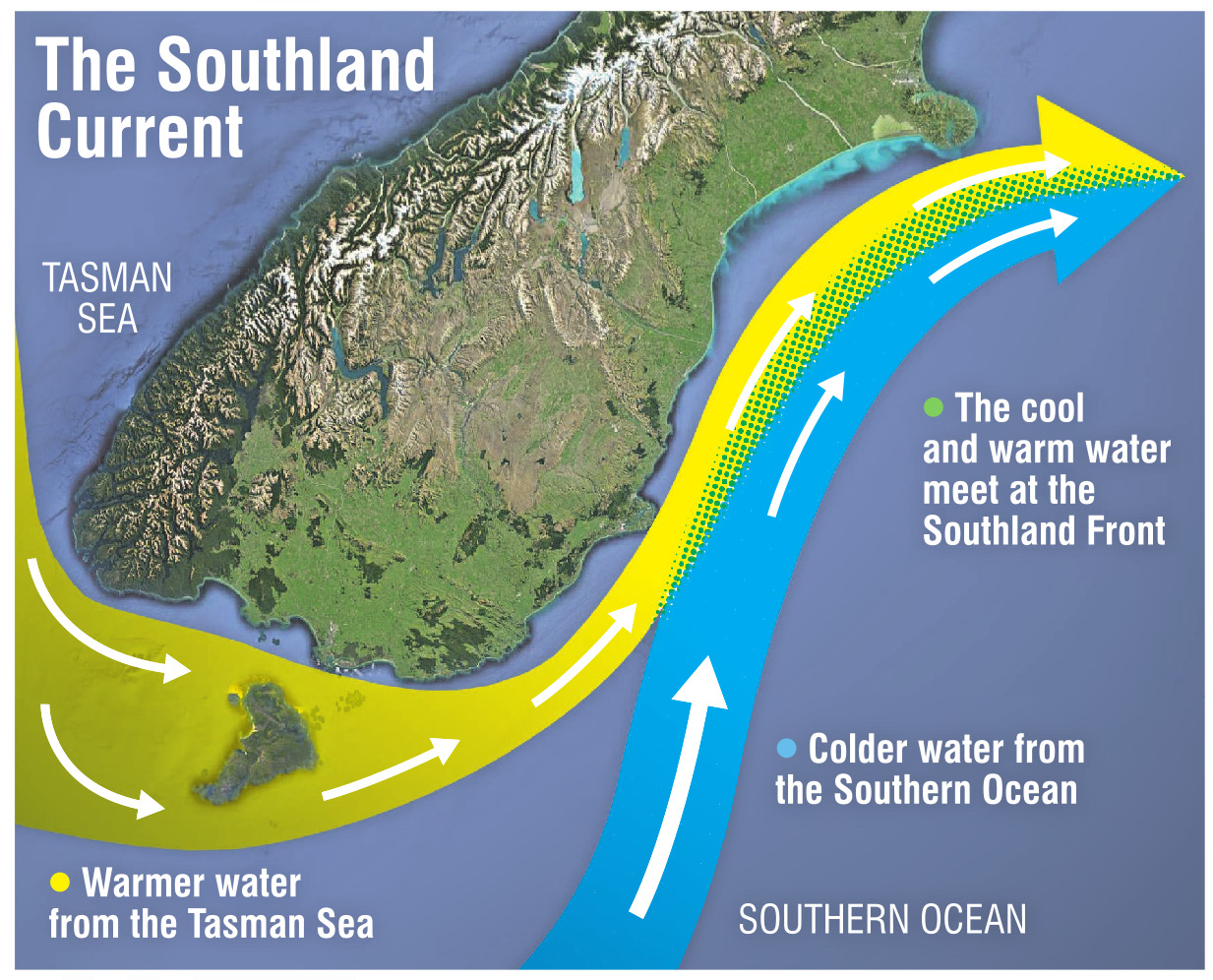
"We’ve got a range of marine species at the bottom of the South Island that are adapted to thrive in the present day environment, and if the Southland Current warms up, that could spell bad news for some of those local species," Dr Smith says. "There’s evidence to show that, globally, water temperatures are rising due to anthropogenic climate change [climate change driven by human activity]. South of New Zealand there’s warming, and even locally we are seeing warmer summers."
While warmer Dunedin summers might not sound like a particular hardship, coastal and marine species beloved of locals, and vaunted by the tourism industry, would disagree. Even a slight temperature change in the ocean could lead to reductions or losses of some of our most important marine species.
Seabird researcher and ecologist Dr Thomas Mattern is particularly concerned about how coastal warming could impact hoiho (yellow-eyed penguins).
"It’s all looking pretty grim," Dr Mattern says. "Our modelling has shown that warming has put tremendous pressure on hoiho in the past 20 years, with reduced productivity at the sea floor as a result of ongoing ocean warming". Dr Mattern is worried that, soon, "the situation for the penguins and our sea floor ecosystem along the coast will take a big hit".
In 2017, Dr Mattern and colleagues published research assessing the influence of climate change on hoiho population trends over the previous 30 years. The research showed that 33% of variation in hoiho population numbers could be explained by related sea surface temperatures, and that these "significantly increased pressure on the penguin population". Since then, coastal temperatures in hoiho foraging habitat have only increased.
Recent data from Statistics New Zealand shows that Aotearoa’s oceanic and coastal waters have reached their warmest annual temperatures on record, in a data set going back to 1982. The coastal waters on the east coast of the South Island proved to be the fastest warming around Aotearoa, increasing by an average of 0.34°C per decade. Not only are the coastal waters warming, but the Southland Current itself is modelled to heat up.
MetService Research and Innovation Hub general manager Dr Brett Beamsley confirms it.
"Climate change predictions analysis, undertaken by Dr Christopher Roach for the Moana Project, suggests that the fastest warming near-coast area in the medium term is in the Southland Current".
In 25 years time, the Southland Current is modelled to be 2.2°C to 2.5°C hotter than it is today.
"People might think this is great, the idea of warmer summers," Dr Smith says. "But this kind of trajectory could be really problematic for marine ecosystems.
"The cold water in the Southland Current is actually playing a really important role in regulating regional temperatures and supporting these ecosystems."
Warmer temperatures could also reduce phytoplankton abundance. Since phytoplankton rely on sunlight, they require dense water to hold them up near the top of the ocean. If the water is not dense enough, they sink away from the sunlight and cannot grow. Since colder water is more dense than warmer water, having lots of cold water around means phytoplankton can stay up near the sunlight.
When there are plenty of phytoplankton, there is plenty of food for small fish, which then feed the bigger fish, and on it goes up the food web. This phenomenon contributes to Otago’s marine wildlife diversity, explains Assoc Prof Rayment.
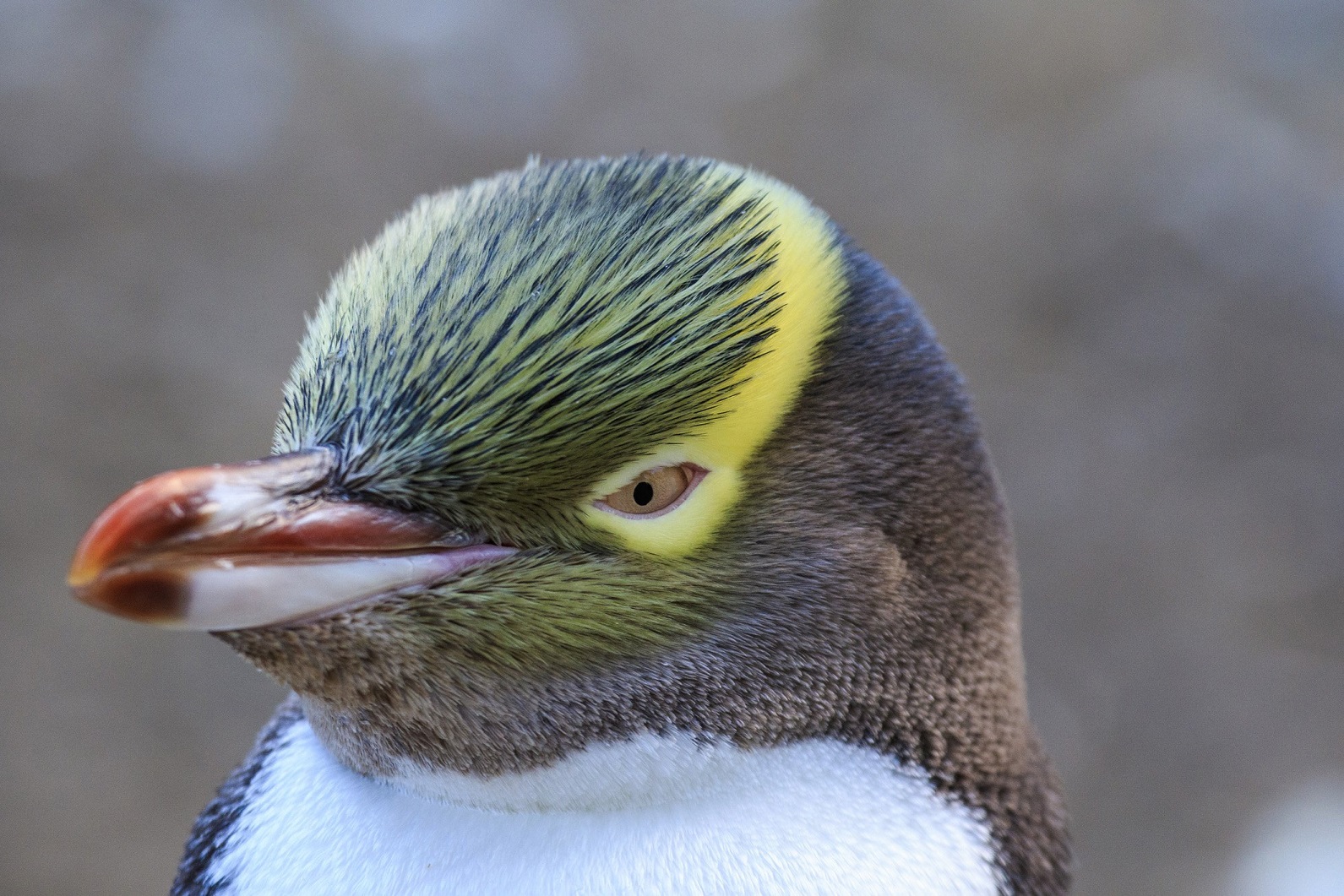
Rayment is "sure that the front is driving productivity up the food chain, which means it could be a really important area for megafauna as well".
Marine megafauna are the larger animals that move around the ocean. They require a great deal of primary productivity in order to support the larger prey they feed on.
"All up and down the east coast and along the south side of Chatham Rise is important foraging habitat for sperm whales. They are deep water foragers, so they could well be affected. We also know there’s a really high diversity of beaked whale species in that region. Those kind of offshore, deep diving species are the ones I’d expect to be affected most".
Part of Assoc Prof Rayment’s concern stems from how little we know.
"I think it’s something we should be really concerned about. I don’t think, at the moment, we understand what the implications will be. I don’t think we understand the system well enough to know exactly what’s going to happen."
While megafauna species may be affected by changes to the Southland Current, they have the advantage of being able to relocate to somewhere more suitable. Not all species have that luxury. Dr Smith is particularly worried about one of the most characteristic species of Otago’s marine landscape.
"We have these huge giant kelp forests that grow between Karitāne and Moeraki," Smith fondly describes.
Every surfer in Dunedin has had the shock of a strand of giant kelp wrapping around their leg, any attentive beach-goer can attest to the vibrant communities of tiny insects and crustaceans surrounding washed-up kelp.
The giant kelp is a crucial part of local ecosystems.
"It is hard to predict some of the climate-related tipping points, but collapse of the locally extensive giant bladder kelp (Macrocystis pyrifera) beds would have significant flow-on effects for biodiversity and productivity of our inshore environment," Doc Otago coastal biodiversity ranger Jim Fyfe says.
"Giant kelp produces oxygen and removes carbon dioxide from the atmosphere, and provides nurseries for fish," Dr Smith explains.
In April 2023, a study published in Nature Communications valued global kelp forests at $773-$934 billion per year, due to the ecosystem services they provide. The ability of kelp to remove atmospheric nitrogen is worth about $303,959 per acre per year, while the average fisheries harvest from kelp is worth nearly $50,000 per year.
The kelp is only one economically valuable aspect of our marine life that could be threatened by changing water temperatures. A recreational fisherman, Dr Smith can vouch for the vibrant marine life associated with giant kelp forests.
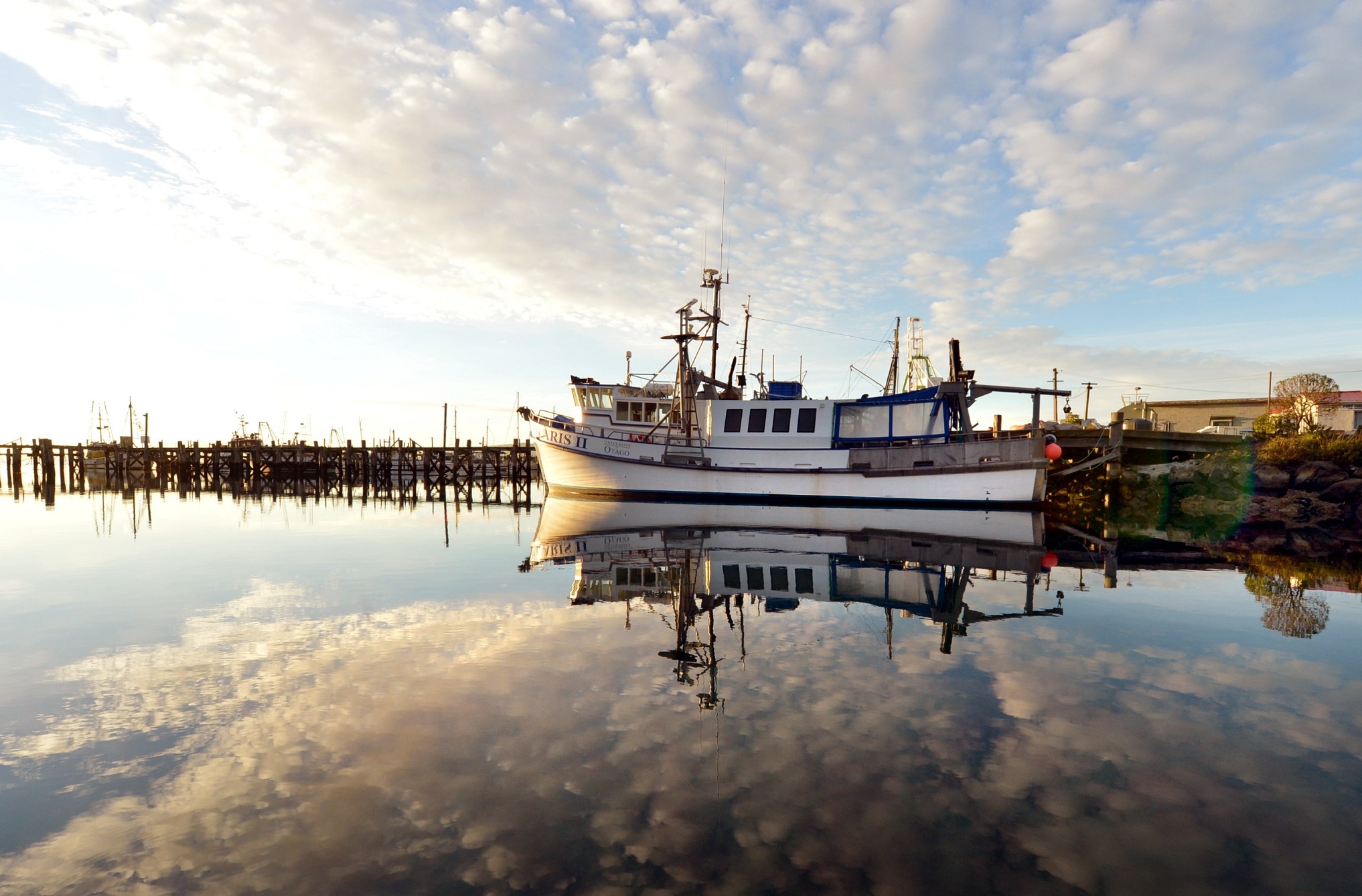
"There’s research showing that when you heat up the water around kelp forests, the adult plants start to die off quite quickly. We’ve seen that happen around the Otago Peninsula.
"If that escalates, that’s going to be a big issue; perhaps not for us, but certainly for our kids and our grandkids. We may well lose this species."
The loss of such an important species would be not only an ecological shock, but also a cultural shock. The giant kelp is as much a part of the region as Kāi Tahu, who have a strong whakapapa relationship with rimurapa (bull kelp).
The water could be warmed in a number of ways. One possibility is that the currents will start to move more quickly, as a result of other climate changes.
The water feeding into the Southland Current from the Tasman Sea comes from a subtropical gyre. A gyre is a big swirling circle of water sitting between continents — like a massive whirlpool. A good way to think about a gyre speeding up is to think of it like stirring a pot, with the stirring spoon representing the winds above the gyre. As the spoon stirs faster and faster, it slowly heats up the water, as a result of frictional energy dissipating as heat.
A similar thing can happen in gyres — if the winds driving the gyre speed up, the water will speed up and heat up too. Water moving faster in the gyre will also mean that any water coming out of the gyre will be travelling faster.
"If the Gyre and the Southern Current speed up and bring more warm water to our coast from the Tasman Sea, that could raise temperatures above the temperatures that kelp can survive in," Dr Smith says.
For a long time, a clock has been ticking in the minds of environmental scientists. Each time RV Polaris II makes the journey out to the Southern Front, the incredible sights and interactions come with an awareness of the fragility of this system — the knowledge that things are changing, and "magic" nutrient potions such as the Southland Current might one day be little more than stories. Losing species and ecosystems associated with the Southland Front, due to warming, could have untold economic, environmental and cultural impacts.
"To be quite honest, I think it would be a huge embarrassment for New Zealand as a whole," Dr Mattern says.
"We advertise ourselves as a clean green country, and then to lose some of the most charismatic animal species on this planet on our doorstep, it’s embarrassing."
With more research going into understanding the Southland Current, and hope for a future with stabilised oceanic temperatures, there is still a chance for systems like the Southland Current. Right now, the biggest concern for many is the lack of certainty we have about what to expect from oceanic climate change impacts, and how long we have to prepare for these.
"The ocean is warming a lot faster than people are predicting," Assoc Prof Rayment warns. "And we’re going to see changes for sure. I just don’t think we know what those changes are yet."
Kaia Kahurangi Jamieson is a University of Otago Humanities intern.






